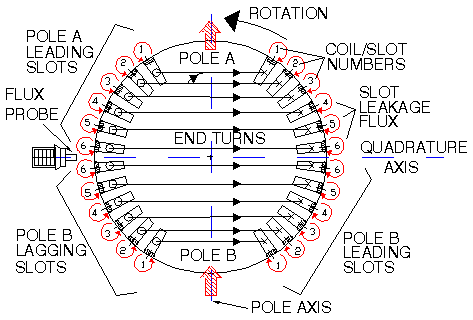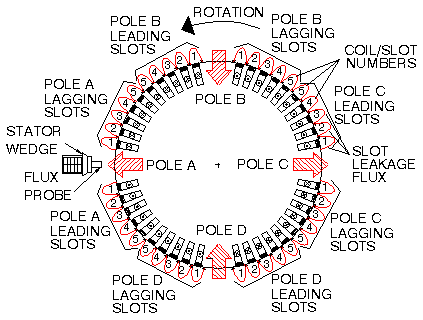Shorted Turns: Cause & Effect
Shorted-turns are the result of failed insulation between individual windings in generator rotors. Stop-Start cycles, line disturbances, contamination, moisture, manufacturer error, and damage during retaining ring installation are some of the reasons insulation fails.
The impact of operating with shorted turns ranges from no-problem to abnormal vibration, load limits, higher operating temperatures and forced outages.
The location and number of shorted turns in a rotor determines the magnitude of the effects of running a rotor with shorted-turns.
As generator units age, shorted-turn problems are more likely to be experienced. The stresses involved in each Stop-Start cycle play an especially important role. Occasionly, newly rewound fields will have shorted-turns.
Shorted-turns in the field winding can cause operating conditions which may limit unit loads. If conditions are extreme, forced outages may occur.
The effects include:
Rotor unbalance that varies with field current changes (thermal sensitivity and/or magnetic unbalance).
Higher field current is required than previously experienced at a specific load.
Higher field currents result in higher operating temperature.
Decreased power generating efficiency.
1. Rotor unbalance that varies with field current changes (thermal sensitivity and/or magnetic unbalance).
Coils with shorted-turns operate at lower temperatures than coils without shorted-turns. This is because the heating resulting from I^2R losses are lower in the effected coil (the coil current is traversing a shorter copper path, thus R is lower for the coil), while the cooling circuits remain the same. The rotor temperature gradient responsible for rotor bowing will be a function of the number of turn-shorts, their location (refer to Figure 1 below) and the magnitude of the field current (which varies with load).
Shorted-turns in coils near the quadrature axis in 2-pole rotors will have little effect on thermal sensitive balance because the effected slots are nearly 180° apart. Shorted-turns in the small coils (1, 2 or 3) of one pole will have a greater effect in causing rotor unbalance problems since the rotor temperature gradient will be more asymmetrical.
Shorted-turns in 4-pole rotors will cause unbalanced magnetic forces. These unbalanced magnetic forces cause rotor vibration along the pole axis that has the turn shorts. Shorted turns in 2-pole rotors do not generally cause an unbalanced magnetic force as the N-S poles are 180 mechanical degrees apart.
2. Higher field current is required than previously experienced at a specific load.
When shorted-turns occur, higher field current is required to maintain a specific load. Excitation capacity may limit load if greater than 5-10% of the field winding is shorted out. The Amp vs. Field-Turn relationship is A_S = A_N*T_N/T_S where A_S and T_S are the field current and active turns in a rotor with shorted-turns and A_N and T_N are the same in a rotor with no shorted-turns. The field winding loss (I^2R) at a specific load can be determined by noting that the resistance of the field winding will decrease by T_S/T_N but the I^2 component increases by (T_N/T_S)^2. This results in an increase in the field winding loss of T_N/T_S for a specific load.
For example, two turns shorted out of one hundred turns of a 5000-KW excitation system will result in approximately 100-KWs higher loss at full load.
3. Higher field currents result in higher operating temperature.
Even though the volts/amp (V/A) field temperatures instrumentation will indicate lower operating temperatures (this is a result of the instrumentation algorithm used to calculate field temperature assuming a constant field resistance), the higher field currents required to maintain a given load will result in an increase in (I^2R) loss for the entire rotor winding.
Because shorted-turns result in higher field current when operating at a given load, the hot-spot winding temperature in coils without shorted-turns are higher.
Winding temperature rise above cold gas is proportional to I^2. Two turns shorted out of 100 turns will result in a 4% higher hot-spot rise over cold gas temperature.
4. Decreased power generating efficiency.
The increase in field current and cooling requirements over what would be required to produce the same amount of energy with a rotor with no shorted turns will reduce the overall power generating efficiency of the unit.



